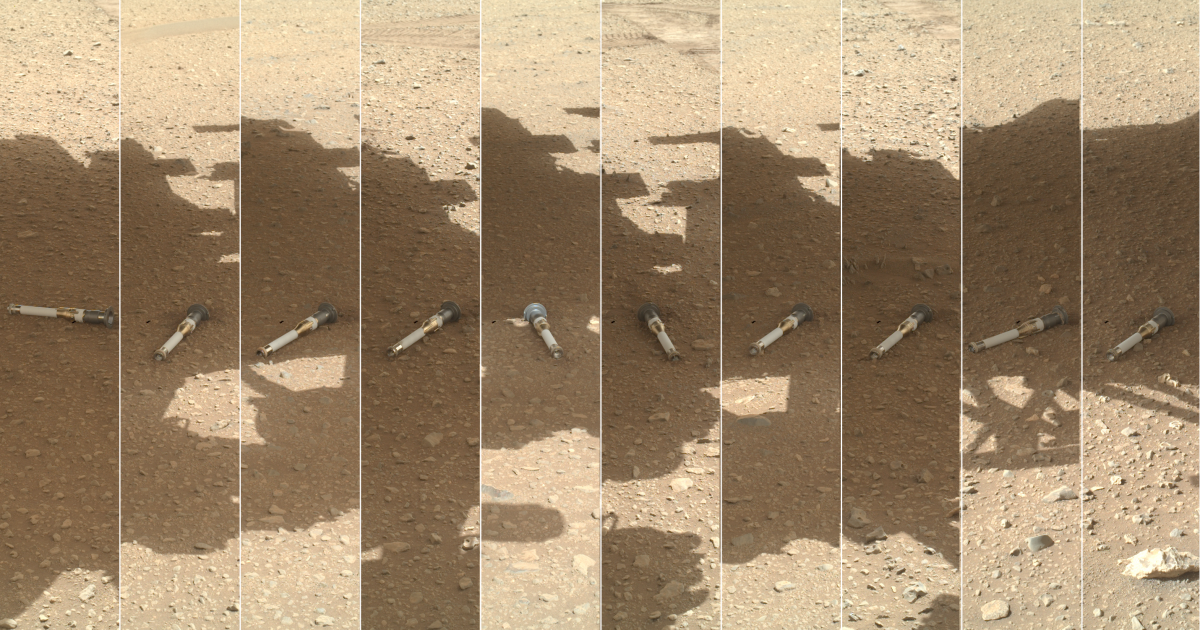Science
Arizona Limits New Construction in Phoenix Area, Citing Shrinking Water Supply

Arizona has determined that there is not enough groundwater for all of the future housing construction that has already been approved in the Phoenix area, and will stop developers from building some new subdivisions, a sign of looming trouble in the West and other places where overuse, drought and climate change are straining water supplies.
The decision by state officials marks the beginning of the end to the explosive development that has made the Phoenix metropolitan region the fastest growing in the country.
Maricopa County, which includes Phoenix and its suburbs, gets more than half its water supply from groundwater; most of the rest comes from rivers and aqueducts as well as recycled wastewater. In practical terms, groundwater is a finite resource; it can take thousands of years or longer to be replenished.
The announcement of a groundwater shortage — what the state calls “unmet demand” for water over the next hundred years — means Arizona would no longer give developers in areas of Maricopa County new permits to construct homes that rely on wells for water.
Phoenix and nearby large cities, which must obtain separate permission from state officials for their development plans every 10 to 15 years, would also be denied approval for any homes that rely on groundwater beyond what the state has already authorized.
The decision means cities and developers must look for alternative sources of water to support future development — for example, by trying to buy access to river water from farmers or Native American tribes, many of whom are facing their own shortages. That rush to buy water is likely to rattle the real estate market in Arizona, making homes more expensive and threatening the relatively low housing costs that had made the region a magnet for people from across the country.
“We see the horizon for the end of sprawl,” said Sarah Porter, director of the Kyl Center for Water Policy at Arizona State University.
The state says it would not revoke permits that have already been issued and is instead counting on water conservation measures and alternative sources to produce the water necessary for approved projects.
A groundwater shortage would likely not derail the planned growth in the short term in major cities like Phoenix, Scottsdale and Mesa, Ms. Porter said.
“There is still capacity for development within designated cities,” Ms. Porter said, referring to cities whose growth plans had already been approved by state water officials. Those cities would not be able to get approval to build anything beyond that amount.
The new restrictions would be felt hardest and most immediately in small towns and unincorporated swaths of desert along the fringes of the Phoenix metro area — where most lower-cost homes tend to get built. “Those have been hot spots for growth,” Ms. Porter said.
The announcement is the latest example of how climate change is reshaping the American Southwest. A historic 23-year drought and rising temperatures have lowered the level of the Colorado River, threatening the 40 million Americans in Arizona and six other states who rely on it — including residents of Phoenix, which gets water from the Colorado by aqueduct.
Rising temperatures have increased the rate of evaporation from the river, even as crops require more water to survive those higher temperatures. The water that Arizona receives from the Colorado River has already been cut significantly through a voluntary agreement among the seven states. Last month, Arizona agreed to conservation measures that would further reduce its supply.
The result is that Arizona’s water supply is being squeezed from both directions — disappearing ground water as well as the shrinking Colorado River.
And the water shortage could be more severe than the state’s analysis shows because it assumes that Arizona’s supply from the Colorado would remain constant over the next 100 years — something that is uncertain.
Arizona’s water problems have begun to percolate through the state’s politics. In January, the new governor, Katie Hobbs, a Democrat, pledged in her first major address to tighten controls on groundwater use around the state.
As evidence of that commitment, Ms. Hobbs released a report that she said had been suppressed by the previous Republican administration. It showed that an area west of Phoenix, called the Hassayampa sub-basin, doesn’t have enough water for new wells. As a result, the Arizona Department of Water Resources said it would no longer issue new permits in that region for home construction that relied on groundwater.
But Hassayampa is just one of several sub-basins that make up the larger groundwater basin underneath metropolitan Phoenix. The state’s announcement on Thursday essentially extends that finding across the Phoenix area.
One of the places likely to feel the impact of the new restrictions is Queen Creek.
When Arizona created its groundwater rules more than 40 years ago, Queen Creek was still mostly peach and citrus groves and expansive farmland. Today, it is one of the fast-growing places in Arizona, where families go fishing at an “oasis” lake fed by recycled wastewater. The town’s population of 75,000 is projected to grow to 175,000 by the time it is built out decades from now.
But to do any of that, the town needs to find more water.
“We’re in search of about 30,000 acre feet” — or about 9.8 billion gallons, said Paul Gardner, Queen Creek’s utility director.
Since there isn’t enough groundwater to supply its needs for future growth, Queen Creek is hunting for water anywhere it can — exploring proposals such as transferring it via canal from western Arizona, expanding the Bartlett Lake reservoir by joining other cities in a project to build a higher dam.
Unlike Phoenix, Queen Creek doesn’t have what’s called a “designation” from the state — essentially, a determination that the city has enough water to support new homes. Without that designation, each proposed development must prove to the state it has a 100-year supply — and developers without that seal of approval would now have to find sources other than groundwater.
Even as the state takes steps to try to slow depletion, the Kyl Center has warned that Arizona is still pumping too much groundwater. New industrial projects are sucking up groundwater without restrictions, and demand for water is outpacing any gains from conservation efforts, the center found in a 2021 report.
Despite the increasingly dire warnings from the state and water experts, some developers are confident that construction will not stop anytime soon. The Arizona water agency has given permission for construction on about 80,000 housing lots that have yet to be built, a state official said.
Cynthia Campbell, Phoenix’s water-resources management adviser, said the city largely relies on river water, and groundwater represents only about 2 percent of its water supply. But that could change dramatically if Arizona is hit with drastic cuts in its Colorado River allotments, forcing the city to pump more groundwater.
Many outlying developments and towns in Maricopa County’s sprawl have been able to build by enrolling in a state-authorized program that lets subdivisions suck up groundwater in one place if they pump it back into the ground elsewhere in the basin.
Ms. Campbell said the idea that you could balance water supplies like that had always been a “legal fiction” — one that now appears to be unraveling, as the state takes a harder look at where the groundwater supplies are coming up short.
“This is the hydrologic disconnect coming home to roost,” Ms. Campbell said.
In outlying areas “a lot of the developers are really worried, they’re freaked,” Ms. Campbell said. “The reality is, it all came back to catch us.”

Science
Column: Two Rutgers professors are accused of poisoning the debate over COVID's origins. Here's why

In a Dec. 2 tweet, Richard H. Ebright, a professor of chemistry and chemical biology at Rutgers University, stated that Anthony Fauci, the respected virologist and retired official of the National Institutes of Health, “is likely a murderer and provably a felon.”
In another tweet a few weeks earlier, he had compared Fauci to the Cambodian dictator Pol Pot, who was responsible for the genocidal massacre of as many as 2 million people in the 1970s.
Referring to an event at Case Western Reserve University honoring Fauci, Ebright wrote: “You may have missed the chance to hobnob with Pol Pot, but, Case Western will give you the chance to hobnob with Fauci, whose policy violations … likely killed 20 million.”
Every time I speak publicly, I now have a thought that there might be someone who has ingested this steady stream of distortions who might shoot me while I’m speaking.
— Michael Worobey, University of Arizona
In a tweet Aug. 25, 2022, Ebright’s colleague Bryce Nickels, a professor in the Rutgers department of genetics, called the “coordination” among virology researchers including Angela Rasmussen of the University of Saskatchewan and Michael Worobey of the University of Arizona an example of “pure, unfiltered evil.”
He illustrated the tweet with a GIF from the 1976 movie “Marathon Man” showing Dustin Hoffman being tortured by a character played by Lawrence Olivier and plainly inspired by Nazi doctor Josef Mengele.
This is the landscape on which a conflict over two theories about the origin of COVID-19 has been waged. One theory attributes the origin to unregulated trading in China of disease-susceptible wildlife, from which the virus that causes the disease is thought to have leaped to humans in a process known as a zoonotic spillover.
The other, the lab leak hypothesis, posits that the virus escaped from a virology lab in Wuhan, China, where it may have been deliberately concocted.
Let’s be clear: There is no evidence for a lab leak. No one has ever produced anything in its favor other than innuendo and conjecture. By contrast, evidence for a zoonotic transfer is almost overwhelming, has grown ever stronger over the years and is widely accepted by virologists and epidemiologists.
Ebright and Nickels are advocates of the lab-leak theory. For years they have been posting online insinuations or outright accusations of fraud, perjury, felonies and murder aimed at scientists who advocate for the zoonotic transfer theory.
Now a dozen scientists, some of whom have been direct targets of Ebright and Nickels, have called on Rutgers to open a formal investigation into whether its two faculty members have crossed the line distinguishing between responsible scientific debate and defamation, harassment, intimidation and threats.
Among the concerns the signatories aired in their March 14 complaint letter is that the professors’ actions and “inflammatory language,” such as “comparisons of working scientists to historical war criminals and mass murderers,” could “put some of us and … our colleagues in physical danger.”
Ebright’s and Nickels’ behavior, the complaint says, has unfolded in an atmosphere that had already produced “harassment including threats of death and/or violence because of our … scientific research.”
Ebright and Nickels say the complaint misrepresents their words and activities. “I never have compared any of the signatories to Josef Mengele or Pol Pot, and I never have characterized any of the signatories as murderers,” Ebright told me by email. He adds, “I also never have threatened or incited violence against any of the signatories.”
He did acknowledge calling four signatories “fraudsters,” based on their authorship of a 2020 scientific paper that favored zoonosis as the origin of COVID-19 and dismissed the lab-leak theory as implausible. “I stand by this characterization,” he wrote. He called the complaint “an effort to silence opponents and to prop up a collapsing narrative.”
Nickels told me by email, “the assertion that I have labeled any of the 12 signatories as murderers or endangered them or their colleagues is false and is defamatory with malice.” In his email, he accused the same four signatories mentioned by Ebright of fraud.
More on that shortly.
The complaint letter says that Ebright and Nickels have engaged in online harassment, intimidation and threats for years. According to Kristian Andersen, an evolutionary biologist at Scripps Research in La Jolla and the organizer of the complaint, a new element in their approach recently appeared: encouraging their followers to engage in physical contact with zoonosis advocates.
On March 12, Nickels tweeted a notice of a scientific conference in Washington at which Peter Daszak, the head of a research funding organization who has long been the target of vituperation by lab-leak advocates, would appear on a panel.
“Don’t miss your chance to meet Peter Daszak, author of the grant many consider the ‘Blueprint’ for SARS-CoV2!” he wrote. The reference was to a groundless accusation beloved by lab-leak advocates that a grant proposal sponsored by Daszak’s organization involved creating a virus in a Chinese lab that became SARS-CoV-2, the virus that causes COVID. Virologists say the grant proposal would not have produced such a virus. In any event, it was not funded.
“That was so far outside of what I would consider to be normal and ethical conduct in science that I said, we need to file a formal complaint,” Andersen told me. The scientists’ letter to Rutgers administrators doesn’t ask for any disciplinary action, but calls for “immediate and serious review by the administration” of public behavior by Ebright and Nickels.
The call by Ebright and Nickels for followers to show up at a talk by Daszak stepped up the anxiety many scientists feel about their own public appearances.
“Every time I speak publicly, I now have a thought that there might be someone who has ingested this steady stream of distortions who might shoot me while I’m speaking,” says Worobey, a signatory of the complaint whose research helped to establish a seafood and wildlife market in Wuhan, not a lab, as the likely site of the first zoonosis transfers. “With those escalations recently, I thought it was time to deal with it head-on.”
Vaccine science, immigration and elections are all battlegrounds for the war between information and disinformation today. The temperature of debates on these topics is only heightened by the tendency of social media platforms such as Twitter (now X) to encourage intemperate speech. But science and health seem to be areas especially vulnerable to efforts at falsification.
A brief primer on the lab-leak hypothesis may be useful here. During the earliest weeks of the COVID pandemic, many virologists examining the SARS-CoV-2 virus, including Andersen, spotted unfamiliar features, some so unusual that they conjectured the features might have been man-made.
Further research in the ensuing weeks revealed, however, that these features were not unusual, but common, and that they could develop in viruses such as SARS2 through natural processes. Andersen and others eventually concluded that a laboratory role in COVID’s emergence was implausible.
That conclusion was written into a seminal paper on the virus published in Nature Medicine on March 17, 2020, and titled “The proximal origin of SARS-CoV-2.” Its authors included Andersen, Robert F. Garry of Tulane University, Andrew Rambaut of the University of Edinburgh and Edward C. Holmes of the University of Sydney.
All four signed the complaint letter to Rutgers. They’re the four scientists Ebright and Nickels accused of fraud in their emails to me, based on the Rutgers scientists’ claim that the proximal origin paper was fashioned to serve what Ebright and Nickels assert was the authors’ and Fauci’s desire to downplay
Fauci’s role in funding virology research in China.
Ebright further accused Andersen and Garry of perjury, based on their denials at a congressional hearing in July that Fauci pressured them to advocate for the zoonosis theory in their paper.
After the paper’s publication, the lab-leak hypothesis moved into the partisan political realm. Republicans in Congress cherish the notion that Andersen and his colleagues deliberately minimized a laboratory role at Fauci’s behest.
There is not a scintilla of evidence for that assertion, as Andersen and Garry made clear by cogently explaining at the July hearing called by conspiracy-addled House Republicans how the normal process of scientific research led them to the paper’s conclusions.
Last March, FBI Director Christopher Wray stated in an interview with Fox News that the bureau had concluded with “moderate confidence” that the virus had escaped from the Chinese lab, but he cited no evidence and didn’t explain its grounds.
The FBI’s assessment had been part of a survey of all U.S. intelligence agencies that largely contradicted the FBI’s position. In June, it was further contradicted by a report from the Office of the Director of National Intelligence, which refuted claims that the Chinese lab had played a role in the pandemic.
That brings us back to Ebright and Nickels. Although insults and invective are hardly uncommon in exchanges over COVID’s origins, their contributions have often carried a remarkably noxious tone.
The defense by both that they never compared the complainants to Pol Pot or Mengele or characterized them as murderers may be true as far as it goes. But it’s too clever by half. The complainants didn’t say in their letter to Rutgers that they themselves were necessarily the targets of Ebright’s and Nickels’ odious comparisons. Their complaint says the pair had “made comparisons of working scientists” — i.e., other scientists — “to historical war criminals and mass murderers.”
So let’s look at the record.
Ebright has repeatedly intimated that Fauci is a murderer, based on his view that his agency funded dangerous virology research in the Chinese lab that produced the pandemic. There is no evidence that any research the U.S. government funded in China produced the SARS-CoV-2 virus, or even that any such research at that lab was scientifically possible.
On Nov. 13, Ebright wrote of Fauci, “any person whose violations of U.S. government policies … resulted in 20 million deaths is, by any rational standard, a murderer.” It’s unclear what “violations” he was referring to.
In a June 27 tweet, Ebright described Fauci as “an octogenarian serially misfeasant, serially malfeasant, serially perjurious, former bureaucrat likely to face criminal charges after Jan 2025” (i.e., presumably assuming that Donald Trump would then take office again).
On Dec. 23 he tweeted that the “only option” to “mitigate the negative effects” of the proximal origin paper was the referral of Andersen and his colleagues “for criminal prosecution.”
On July 10, 2021, Ebright responded with the following comment to a tweet that apparently had alluded to critics of the lab-leak theory: “Sociopaths will be sociopaths … See Mengele. See Ishii.” The latter reference is to Shirō Ishii, who headed Japan’s World War II bioweapons program, which has been blamed for the deaths of as many as 300,000 people.
On Sept. 5 and 6, 2022, Ebright summarized the case for the lab-leak hypothesis, which he tied to “labs conducting world’s largest research program on bat SARS-like coronaviruses.” He ended the thread with the phrase “The banality of evil” — philosopher Hannah Arendt’s description of the impression left on her by Adolph Eichmann, the architect of the Nazi program of Jewish genocide, whose trial in Israel she reported on.
Nickels, in addition to posting the Mengele-linked film clip, earlier this month tweeted “massive respect to … military veterans that have taken a stand” against scientists he asserted had lied about research “impacting national security.” He called the behavior of such scientists “treasonous” and he specifically named among those deserving respect, one Andrew G. Huff.
One day earlier, Huff, who labels the zoonosis theory a “lie,” tweeted a call for Fauci, Daszak and virologist Ralph Baric of the University of North Carolina to be hauled before a military tribunal. Subsequently, he tweeted that his followers had voted in an online poll that if convicted, they should be hanged. He illustrated that tweet with a film clip of three people plunging to their deaths on a gallows.
The ball is now in Rutgers’ court. The university says the complaint “will be forwarded to the appropriate offices for review.” It didn’t say what issues would be considered. But certainly a determination would be warranted of whether its faculty members’ actions conform to the school’s policy on free expression, which frowns on actions or behaviors that “threaten individuals or cause an injury to someone” or “harass, threaten violence, or intimidate others.”
Whatever the outcome is of any such inquiry, the scientific community is right to be appalled by Ebright’s and Nickels’ activities. There’s vast latitude in science for disagreement and debate, but calling one’s adversaries or critics criminals or traitors, or placing them in the same category as Mengele, Eichmann and Pol Pot? That isn’t scientific debate.
In the world of science, the reputations of Andersen, Worobey, Garry, Holmes and Rambaut are secure; their finding that COVID most likely originated in the wildlife trade has not only held up over time but also been validated by subsequent studies. The same is true of the other eight signatories of the complaint letter, and Fauci and Daszak (who are not signatories).
Ebright and Nickels? They may be a different story.
Science
Too expensive, too slow: NASA asks for help with JPL's Mars Sample Return mission

After months of turmoil over the future of a vaunted mission to bring samples of the Red Planet back to Earth, NASA has its verdict on Mars Sample Return.
The space agency is “committed” to bringing those rocks back from Mars, Administrator Bill Nelson said Monday, but will have to do it with way less money and in far less time than currently designed.
And how exactly is NASA going to pull that off? Right now it has no idea — and it’s looking for someone who does.
“I have asked our folks to reach out with a request for information to industry, to [the Jet Propulsion Laboratory] and to all NASA centers, and to report back this fall an alternate plan that will get [the samples] back quicker and cheaper,” Nelson said in a press conference at NASA headquarters.
His comments came in response to an independent review commissioned by NASA last year that declared there was “near zero probability” of Mars Sample Return making its proposed 2028 launch date, and “no credible” way to fulfill the mission within its current budget.
Pulling off the mission as designed would likely cost up to $11 billion, the review board found, with the samples not reaching Earth until at least 2040.
“The bottom line is that $11 billion is too expensive, and not returning samples until 2040 is unacceptably too long,” Nelson said. “It’s the decade of the 2040s that we’re going to be landing astronauts on Mars.”
The announcement comes as something of a blow to JPL, the La Cañada Flintridge institution tasked with managing the mission. JPL has already laid off more than 600 employees and 40 contractors this year after NASA ordered it to reduce spending in anticipation of budget cuts spurred by the challenges of Mars Sample Return.
Proposals go out soon to all NASA centers and the private aerospace sector for “a revised plan that utilizes innovation and proven technology to lower risks, to lower costs and to lower mission complexity so we can return these really precious samples to Earth in the 2030s,” said Nicky Fox, associate administrator, Science Mission Directorate. The due date for proposals is next month, and those selected for further study will get NASA grants this summer.
This essentially puts JPL in a position of having to compete for its own project.
“Right now if JPL were to come up with the answer, then I’d say JPL is gonna be sitting pretty good,” Nelson said during Monday’s news conference. “But we’re opening this up to everyone because we want to get every new and fresh idea that we can.”
NASA’s decision to outsource a solution to the Mars Sample Return problem frustrated some Mars scientists.
“What I expected is for NASA to step up and say, ‘These things are hard and we choose to do them,’ ” said Bethany L. Ehlmann, a planetary scientist at Caltech. “That is the leadership required to be the nation leading the world in space exploration.”
A joint project with the European Space Agency, Mars Sample Return would deliver rocks, rubble and dust that have already been gathered and sealed into tubes by the Perseverance rover.
The current design relies on a lander that would retrieve those tubes from the Red Planet’s Jezero Crater and use a small rocket to ferry them into Martian orbit, where they would rendezvous with a spacecraft that would make the journey back to Earth. The rocket would touch down on Earth roughly five years after the orbiter’s launch.
The ultimate goal is to comb the samples for evidence that life has ever existed on Mars, and to help NASA plan for future crewed missions, Nelson said.
In the most recent planetary science decadal survey, a report prepared for NASA every 10 years by the National Academy of Sciences, Engineering, and Medicine, planetary scientists named the Mars Sample Return mission as the “highest scientific priority of NASA’s robotic exploration efforts this decade” and argued that the program should be completed “as soon as is practicably possible with no increase or decrease in its current scope.”
But the authors cautioned that the ambitious mission shouldn’t come at the cost of other planetary science, suggesting a roughly $5-billion to $7-billion cap.
“Mars Sample Return is of fundamental strategic importance to NASA, U.S. leadership in planetary science, and international cooperation and should be completed as rapidly as possible,” the report stated. “However, its cost should not be allowed to undermine the long-term programmatic balance of the planetary portfolio.”
The agency is committing to keeping the mission within that recommended budget, Nelson said. Allowing Mars Sample Return’s costs to reach the $8 billion to $11 billion the review board estimated would require NASA “to cannibalize other programs, other science programs, and there are so many that are absolutely important,” Nelson said.
Science
'Miracle' weight-loss drugs could have reduced health disparities. Instead they got worse

The American Heart Assn. calls them “game changers.”
Oprah Winfrey says they’re “a gift.”
Science magazine anointed them the “2023 Breakthrough of the Year.”
Americans are most familiar with their brand names: Ozempic, Wegovy, Mounjaro, Zepbound. They are the medications that have revolutionized weight loss and raised the possibility of reversing the country’s obesity crisis.
Obesity — like so many diseases — disproportionately affects people in racial and ethnic groups that have been marginalized by the U.S. healthcare system. A class of drugs that succeeds where so many others have failed would seem to be a powerful tool for closing the gap.
Instead, doctors who treat obesity, and the serious health risks that come with it, fear the medications are making this health disparity worse.
“These patients have a higher burden of disease, and they’re less likely to get the medicine that can save their lives,” said Dr. Lauren Eberly, a cardiologist and health services researcher at the University of Pennsylvania. “I feel like if a group of patients has a disproportionate burden, they should have increased access to these medicines.”
Why don’t they? Experts say there are a multitude of reasons, but the primary one is cost.
The injectable drug Ozempic sparked a revolution in obesity care.
(David J. Phillip/Associated Press)
Ozempic, which is approved by the Food and Drug Administration to help people with Type 2 diabetes control their blood sugar and reduce their risk of serious cardiovascular problems like heart attacks and strokes, has a list price of $968.52 for a 28-day supply. Wegovy, a higher dose of the same medicine that’s FDA-approved for weight loss in people with obesity or who are overweight and have a weight-related condition like high blood pressure or high cholesterol, goes for $1,349.02 every four weeks.
Mounjaro is a similar drug approved by the FDA to improve blood sugar levels in Type 2 diabetes patients, and it comes with a list price of $1,069.08 for 28 days of medicine. Zepbound, a version of the same drug approved for weight loss, has a slightly lower price tag of $1,059.87 per 28 days. For now, at least, all the new drugs are meant to be taken indefinitely.
Few health insurance programs cover the medications when prescribed to help people reach and maintain a healthy weight. Federal law requires that weight loss drugs be excluded from basic coverage in Medicare Part D plans, and as of early 2023, only 10 states included an antiobesity medication in the formularies for their Medicaid programs.
“If everybody had equal access, then this would be a way to help,” said Dr. Rocio Pereira, chief of endocrinology at Denver Health. “But without equal access — which is what we have now — it’s likely this is going to increase the disparity we see.”
U.S. obesity rates have been rising for decades, and they’re consistently higher for Black and Latino Americans. Among adults 20 and older, 49.9% of Black Americans and 45.6% of Hispanic Americans have a body mass index of 30 or greater, compared with 41.1% of white American adults and 16.1% of Asian American adults, according to age-adjusted data from the Centers for Disease Control and Prevention.
Obesity rates are also associated with income. In 2022, the age-adjusted rate was 38.4% for adults with household incomes between $15,000 and $24,999, compared with 34.1% for those with household incomes of $75,000 or more.
The two are related, said Pereira, who studies health disparities in diseases related to obesity. Black and Latino Americans are more likely to live in lower-income neighborhoods, where fast food is usually cheaper and more convenient than grocery stores.
“If you look at a map of the U.S. and plot out the neighborhoods where there’s no grocery store within a mile and there’s a high percentage of people who have no car, those are the areas where there’s the highest rates of obesity,” she said.
There’s also the time factor, she said: “Can you afford to cook your own meals, or do you have to work two jobs?”
An unusual experiment by the Department of Housing and Urban Development demonstrated the degree to which physical surroundings can influence obesity risk, Pereira said. In the 1990s, hundreds of mothers who were living in public housing were offered housing vouchers they could use only in wealthier neighborhoods. Ten to 15 years later, the women randomly assigned to receive the windfall had significantly lower rates of severe obesity (14.4%) than women in a control group who weren’t offered vouchers (17.7%). They were also less likely to have a body mass index of 35 or higher (31.1% vs. 35.5%).

Two women talk in New York.
(Mark Lennihan / Associated Press)
The American Medical Assn. recognized obesity as a disease in 2013. People with the chronic condition are at heightened risk of cardiovascular disease, Type 2 diabetes, 13 types of cancer, osteoarthritis, asthma and other health problems. Researchers have pegged the annual medical costs associated with obesity at $174 billion in the U.S. alone.
Some people with obesity are able to lose weight by changing their diets and burning more calories through exercise. But that doesn’t work for people who have developed resistance to leptin, a hormone that suppresses appetite.
“If you try to lose weight with diet and exercise, your body is going to fight you,” said Dr. Caroline Apovian, co-director of the Center for Weight Management and Wellness at Brigham and Women’s Hospital in Boston. “Your leptin levels go down, and when leptin goes down, a signal goes to the brain that you don’t have enough fat to survive.” That prompts the release of another hormone, ghrelin, that triggers feelings of hunger.
Leptin resistance also makes exercise less worthwhile.
“Your body fights you by decreasing your total energy expenditure,” Apovian said. “When your muscles work, they work more efficiently. If you want to lose 10 pounds, you’re going to get really, really hungry. And you can’t fight that. Your body thinks it’s starving to death.”
The “breakthrough” drugs counteract this by impersonating a hormone called glucagon-like peptide 1, or GLP-1, that’s involved in appetite regulation. Inside cells, the drugs bind with the same receptors as GLP-1, reducing blood sugar and slowing digestion. They also last longer than their natural counterparts.

Oprah Winfrey credits the new generation of medications for helping her keep her weight under control.
(Chris Pizzello / Associated Press)
The first so-called GLP-1 receptor agonist was approved in 2005 to treat diabetes, and early versions had to be injected once or twice a day. Ozempic improved on this by requiring an injection only once a week. After clinical trials showed that the drug helped people with obesity achieve substantial, sustainable weight loss, the FDA approved Wegovy as a weight management drug in 2021.
Mounjaro and Zepbound also mimic GLP-1, along with a related hormone called glucose-dependent insulinotropic peptide, or GIP.
Linda Morales credits Ozempic and Mounjaro for helping her lose 100 pounds and drop from a size 22 to a size 14. The 25-year-old instructional aide at Lankershim Elementary School in North Hollywood said she started to become overweight in middle school and carried 293 pounds on her 5-foot, 5-inch frame when she was referred to the Center for Weight Management and Metabolic Health at Cedars-Sinai two years ago.
She is no longer breathless when she climbs stairs, has an easier time when she goes bowling and fits comfortably into the seat on the Harry Potter ride at Universal Studios. Thanks to the medications, she is no longer on a path toward Type 2 diabetes.
Her job with the Los Angeles Unified School District comes with health insurance that covers the pricey drugs and charges her a copay of $30 a month for her Mounjaro prescription. She said she could swing a monthly payment of up to $50, but beyond that she’d have to stop taking the drug and hope the lifestyle changes she’d made would be enough to sustain the weight loss she’s achieved so far.
“It would definitely get hard for me, for sure,” Morales said.
Indeed, even when the drugs are covered by insurance or patients qualify for discounts from pharmaceutical companies, researchers have found that they often remain out of reach.
In one study, Eberly and her colleagues examined insurance claims for nearly 40,000 people who received a prescription for GLP-1 copycats. Patients who had to pay at least $50 a month to fill their prescriptions were 53% less likely to get most of their refills over the course of a year compared to patients whose copayments were less than $10. Even patients whose out-of-pocket costs were between $10 and $50 were 38% less likely to buy the medicine regularly for a full year, the team found.
In another study of insured patients with Type 2 diabetes, those who were Black were 19% less likely to be treated with these drugs than those who were white, while Latino patients were 9% less likely to get them, Eberly and her colleagues reported.
In some parts of the country, Black patients with diabetes are only half as likely as white patients to get GLP-1 drugs, according to research by Dr. Serena Jigchuan Guo at the University of Florida, who studies health disparities in pharmaceutical access. The disparity was greatest in places with the highest overall usage of the medications, including New York, Silicon Valley and South Florida.
“In those places, the drug is actually widening the gap,” she said.
Researchers have spent years documenting racial disparities in the use of effective treatments for obesity, such as bariatric surgery. Newer drugs like Ozempic simply bring the problem into sharper focus, said Dr. Hamlet Gasoyan, an investigator with the Cleveland Clinic’s Center for Value-Based Care Research.
“We get excited every time a new, effective treatment becomes available,” Gasoyan said. “But we should be equally concerned that this new and effective treatment reduces disparities between the haves and have-nots.”
-

 News7 days ago
News7 days agoVideo: Election Officials Continue To Face Violent Threats
-

 Science1 week ago
Science1 week agoThe Eclipse Across North America
-
Fitness1 week ago
This exercise has a huge effect on our health and longevity, but many of us ignore it
-

 Movie Reviews1 week ago
Movie Reviews1 week agoSasquatch Sunset (2024) – Movie Review
-

 Uncategorized1 week ago
Uncategorized1 week agoANRABESS Women’s Casual Loose Sleeveless Jumpsuits Adjustbale Spaghetti Strap V Neck Harem Long Pants Overalls with Pockets
-

 Finance1 week ago
Finance1 week agoSponsored: Six Ways to Use Robinhood for Investing, Retirement Planning and More
-

 Politics1 week ago
Politics1 week agoVideo: Biden Announces New Plan for Student Debt Relief
-

 Crypto1 week ago
Crypto1 week agoAnalyzing the Environmental Impact of Cryptocurrency Mining














